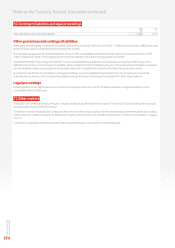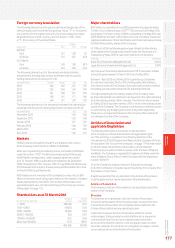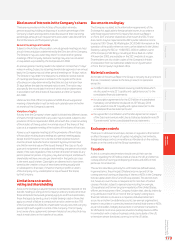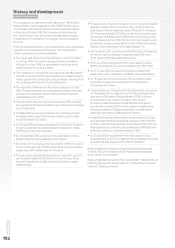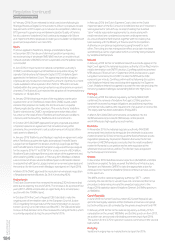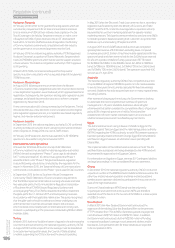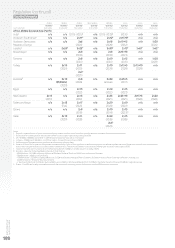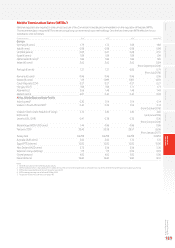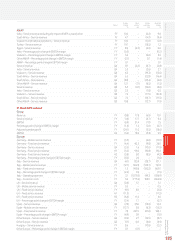Vodafone 2016 Annual Report Download - page 185
Download and view the complete annual report
Please find page 185 of the 2016 Vodafone annual report below. You can navigate through the pages in the report by either clicking on the pages listed below, or by using the keyword search tool below to find specific information within the annual report.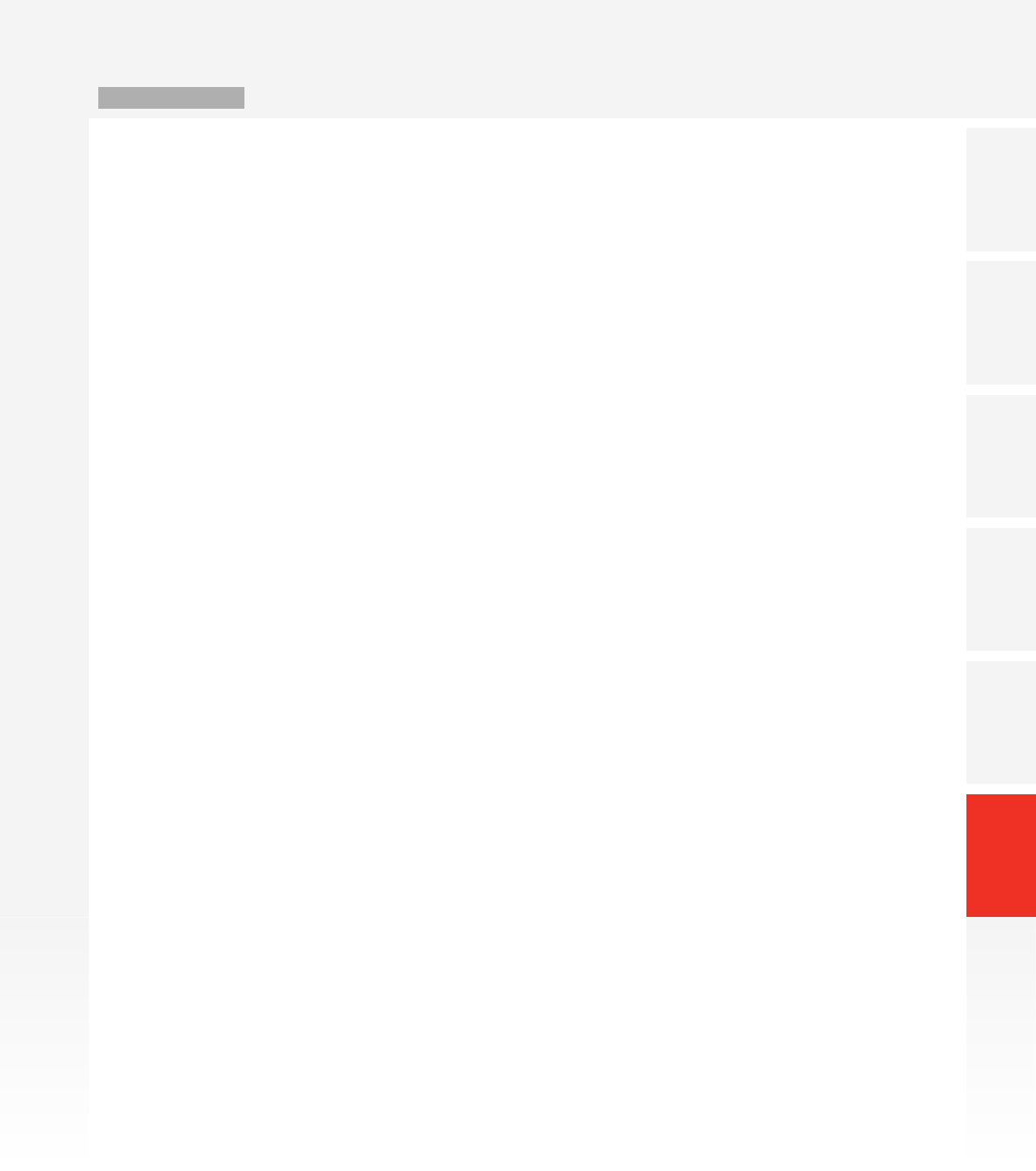
Overview Strategy review Performance Governance Financials
Additional
information
Vodafone Group Plc
Annual Report 2016
183
Regulation
Unaudited information
Our operating companies are generally subject to regulation governing
the operation of their business activities. Such regulation typically
takes the form of industry specic law and regulation covering
telecommunications services and general competition (antitrust)
law applicable to all activities.
The following section describes the regulatory frameworks and the
key regulatory developments at national and supranational level and
in selected countries in which we have signicant interests during the
year ended 31 March 2016. Many of the regulatory developments
reported in the following section involve ongoing proceedings
or consideration of potential proceedings that have not reached
a conclusion. Accordingly, we are unable to attach a specic level
of nancial risk to our performance from such matters.
European Union (‘EU’)
In October 2015 the European Parliament and the European
Council adopted the European Commission’s (‘the Commission’)
proposed regulation known as the Telecoms Single Market Package.
The regulation requires the abolition of retail roaming surcharges
by June 2017 and introduces net neutrality rules which come into force
from 30 April 2016.
In May 2015 the Commission published the Digital Single Market
strategy, aimed at producing a more advanced digital single market.
The strategy has three pillars: (i) maximising the growth potential of the
European digital economy; (ii) creating the right conditions for digital
networks and services to ourish; and (iii) better access for consumers
and businesses to online e-goods and services across Europe.
The Commission is currently undertaking various consultations which
will lead to the revision of existing, or the adoption of new, legislation.
One of these consultations considers the revision of the EU telecoms
regulatory framework that covers ve areas: Next-Generation Access
(‘NGA’) regulation, spectrum, rules for communications services,
universal service, and the institutional set-up and governance.
There is a clear focus on incentivising investment in NGA (including
access for mobile backhaul), the further harmonisation of spectrum
regulation and the creation of a fair and level playing eld for
competing services.
Other consultations we have or are responding to include: Internet
speed and quality; review of national wholesale roaming markets, fair
use policy and the sustainability mechanism; online platforms, cloud &
data, liability of intermediaries, collaborative economy; ICT Standards;
tackling unjustied geo-blocking; the needs for internet speed and
quality beyond 2020; review of the Satellite and Cable Directive;
the revision of the Audio Visual Media Services Directive; contract rules
for online purchases of digital content and tangible goods; the ePrivacy
Directive; and the evaluation of Commission Recommendation
2009/396/EU on the regulatory treatment of xed and mobile
termination rates in the EU.
The Commission are also planning a consultation on the review of safety
of apps and other non-embedded software.
Europe region
Germany
In June 2015 Vodafone Germany acquired 110MHz out of the 270MHz
made available in the spectrum auction. This consisted of 2x10MHz
of 700MHz band, 2x10MHz of 900MHz band, 1x20MHz of 1500MHz
band and 2x25MHz of 1800MHz band for a total of €2,091 million.
Total auction bids amounted to €5,081 million.
In February 2016 Deutsche Telekom applied for approval of new
Unbundled Local Loop (‘ULL’) fees that would lead to an average
increase of 10% and would be valid until the end of 2019. On 20 April
2016 the National Regulatory Authority (‘BNetzA’) proposed reducing
the existing ULL rates by up to 1.7%. The rate decision will, after
EU consolidation proceedings, become effective on 1 July 2016.
In April 2016 BNetzA issued its draft decision on Deutsche
Telekom’s layer 2 bitstream access product proposal. The nal BNetzA
decision is expected in June 2016. Furthermore, BNetzA has proposed
to mandate an additional Virtual Unbundled Local Access (‘VULA’)
product at street cabinets which is not currently technically and
commercially dened.
In May 2016 the Commission announced that BNetzA’s proposal
to allow DT the exclusive deployment of vectoring within the nearshore
areas of the main distribution frames may not be compliant with EU law,
based on the apparent restrictions it places on alternative operators.
Therefore the vectoring proposal and the associated conditions for
the new VULA product will be subject to further scrutiny, with the
Commission due to announce its decision by September 2016.
Italy
In September 2015 Vodafone obtained one of the two L band TDD
blocks equal to 20MHz at just under €232 million. The licence
commenced on 1 January 2016 and expires on 31 December 2029.
In December 2015 further to its investigation into irregularities in the
maintenance services of xed networks, the Italian competition
authority (‘AGCM‘) announced its decision to ne Telecom Italia (‘TI’)
€21.5 million on the basis it had engaged in agreements with six other
undertakings that abused its market dominance. In accordance with the
decision, TI is now obliged to provide unbundled access to maintenance
activities and to allow their competitors to acquire maintenance services
from third parties.
In December 2015 the National Regulatory Authority (‘AGCOM’)
adopted the nal decision regarding the wholesale xed access market.
The decision requires the application of the same remedies and prices
nationally, cost orientation for all wholesale copper and bre access
services and price reductions from 2015 to 2017 for VULA bre to the
cabinet (‘FTTC’) (-36%) and copper bit-stream (-18%).
For information on litigation in Italy, see note 30 “Contingent liabilities
and legal proceedings” to the consolidated nancial statements.
United Kingdom
In September 2015 the national regulatory authority (‘Ofcom’)
published its nal decision revising the annual licence fees payable
on licences for the use of spectrum in the 900MHz and 1800MHz
bands to reect full market value, following the completion of the
4G auction. From 31 October 2016 Vodafone UK will pay annual
fees of approximately £50 million for the spectrum. An application
has been made by Everything Everywhere (‘EE’) to appeal this
decision. Vodafone has given notice of its intention to intervene in any
resulting appeal.
In May 2016 the European Commission competition authority
(‘DGCOMP’) announced its decision to prohibit the proposed Hutchison
3G acquisition of Telefonica UK (‘O2’). Hutchinson 3G have the option
to appeal to the EU’s General Court in Luxembourg.
In December 2015 Vodafone UK acquired 20MHz of 1400MHz
spectrum with an indenite licence from Qualcomm.
In January 2016 British Telecom’s acquisition of mobile network
operator EE received nal approval from the UK’s Competition and
Markets Authority (’CMA’).



